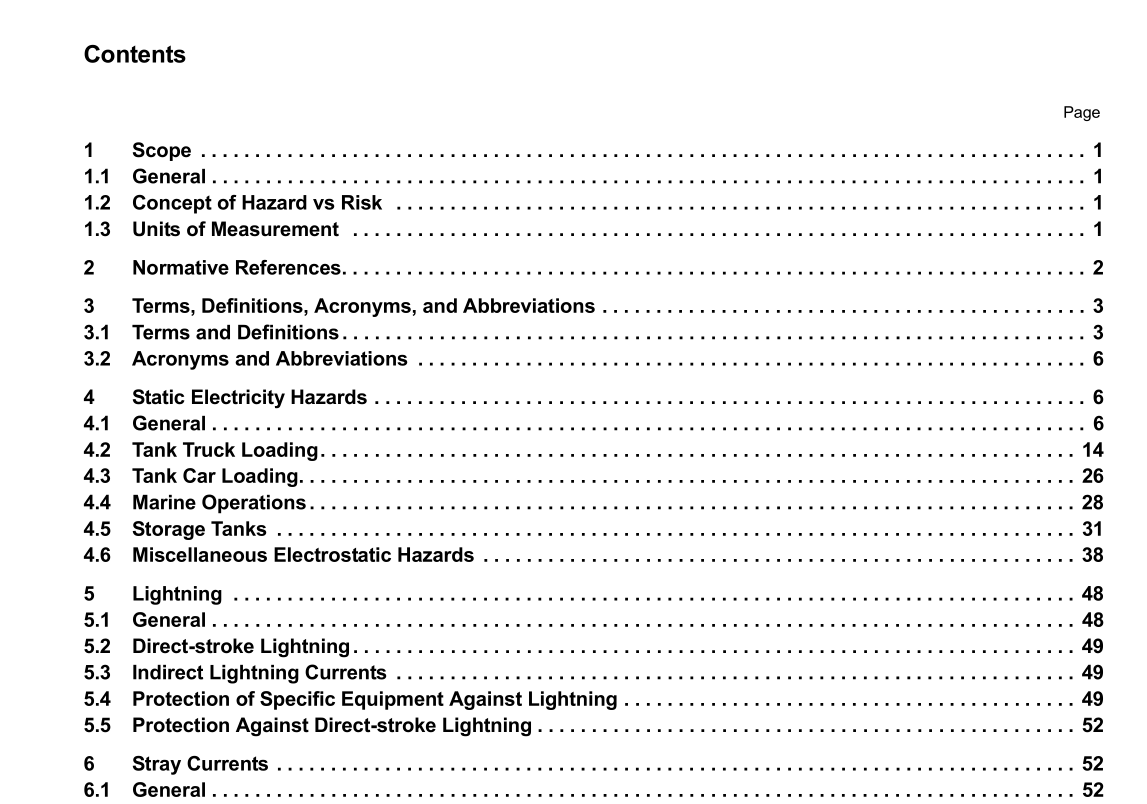API RP 2003 pdf download

API RP 2003 pdf download.Protection Against Ignitions Arising Out of Static, Lightning, and Stray Currents
1 Scope
1.1 General
This recommended practice (RP) presents the current state of knowledge and technology in the fields of static electricity, lightning, and stray currents applicable to the prevention of hydrocarbon ignition in the petroleum industry and is based on both scientific research and practical experience. Furthermore, the principles discussed in this RP are applicable to other operations where ignitable liquids and gases are handled. Their use should lead to improved safety practices and evaluations of existing installations and procedures. When the narrow limits of static electricity ignition are properly understood, fire investigators should be encouraged to search more diligently for the true ignition sources in instances where static ignition is unlikely or impossible. Following this recommended practice is not required where: a) static discharges may occur, but flammable vapors are verified to be excluded by gas freeing or inerting the atmosphere in the area of discharge; b) product handling occurs in a closed system, and oxygen in that system is verified to be below the minimum concentration required to support combustion, such as in the handling of liquefied petroleum gas (LPG); c) the flammable concentration is verified to be above the upper flammable limit (UFL). This document does not address electrostatic hazards relating to solids handling. (See [4], [5], and [15] in the Bibliography.) Vehicle fueling (truck or passenger car) is also outside the scope of this document.
1.2 Concept of Hazard vs Risk
Hazards are situations or properties of materials with the inherent ability to cause harm. Flammability, toxicity, corrosivity, stored electrical, chemical, or mechanical energy all are hazards associated with various industrial materials or situations. Charge separation and the accumulation of a static charge are inherent properties of low conductivity hydrocarbon fluids. Risk includes a consequence such as a hot surface or material that can cause thermal skin burns or a corrosive acid can cause chemical skin burns, but these can occur only if there is contact to the skin. An accumulated static charge can be a source of ignition only if exposed to a flammable fuel-air mixture under conditions where a discharge is possible. There is no risk when all the required elements do not exist; charge accumulation, flammable mixture, and spark discharge. Determining the level of risk involves estimating the probability and severity of exposure of an event that could lead to harm. While the preceding examples relate hazards to the risk to people, the same principles are valid for evaluating risks to property and the environment. For instance, hydrocarbon vapors in a flammable mixture with air can ignite if exposed to a source of ignition (such as a static discharge) resulting in a fire which could injure people or damage property.
3 Terms, Definitions, Acronyms, and Abbreviations
3.1 Terms and Definitions For the purposes of this document, the following definitions apply. 3.1.1 arc An electrical discharge that occurs at the instant two points, through which a large current is flowing, are separated. Technically, electrostatic discharges are always sparks, not arcs. 3.1.2 bonding The practice of providing electrical connections between isolated conductive parts of a system to preclude voltage differences between the parts (see Figure A.5). The low current associated with static charges can be satisfactorily bled off using small wires over long distances. In field use, a strong wire resistant to physical damage may be needed, in which case a bond wire may be sized for physical or mechanical strength. These larger wires typically have low resistance. The process of connecting two or more conductive objects together by means of a conductor so that they are at the same electrical potential does not necessarily mean they are at the same potential as the earth. NOTE A bond resistance as high as 1 megohm (10 6 ohms) can be adequate for static dissipation. However, for stray current protection, lightning protection, and other electrical systems, the bonding resistance needs to be significantly lower, no more than a few ohms. 3.1.3 closed connection A connection in which contact is made before flow starts and is broken after flow is completed (e.g. bottom loading of tank trucks). 3.1.4 combustible liquid A liquid with a flash point at or above 100 °F (38 °C) as defined by NFPA 30.









